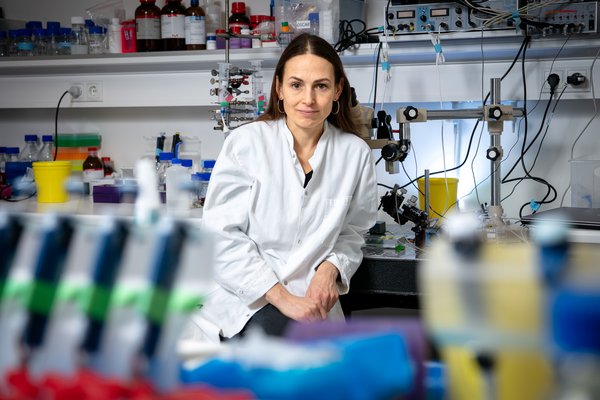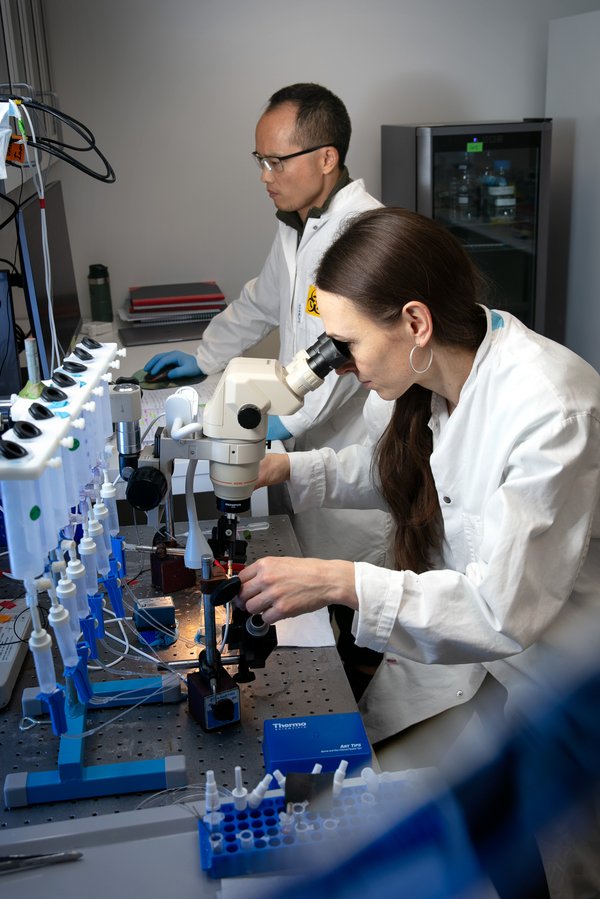Unlocking potential drug targets inside cells
The purpose of the P2P CPP project was to gain a better understanding of cell penetrating peptides (CPPs) and thereby help accelerate the use of CPPs in drug delivery. Read here what the P2P CPP team learned.
The inside of your cells is crowded with millions of proteins and other molecules. Many of them can potentially serve as drug targets for some of the most common diseases such as obesity, cancer and diabetes. The problem is, however, that the inside of your cells is exactly that: The inside. Each cell is protected by a membrane that carefully separates the inside of the cells from the outside surroundings. Some molecules can pass through the membrane on their own if they are small and hydrophobic enough. Other molecules have intricate mechanisms for entering the cell.
You can think of the cell membrane as a wall around your house. There are different doors in the wall and each of them can be unlocked with a different key. If you don’t have a key, you can’t get in unless you want to break down the wall - but this comes with a risk of ruining a bearing structure.
Cell penetrating peptides – potential keys to new drug targets
“The majority of potential drug targets are found inside the cell. Some drugs are very effective when they are tested in cell-free assays in the lab, but the drugs don’t work when tested in cells. They simply can’t cross the cell membrane,” says Hanne Poulsen. She was heading the P2P CPP project, which focused on drug delivery for intracellular targets. Hanne Poulsen and the P2P CPP team aimed to find out how drugs can cross the cell membrane without ruining the cell membrane. “For drugs to pass through the membrane, you need something that has the very right properties. You need a key to unlock the right door. If you don’t have a key, you’ll end up making a hole in the cell membrane and thereby risk destroying the cell or at least affecting it negatively,” she explains and points out that is corresponds to breaking down a bearing structure of a house.
The P2P CPP team’s attention was directed towards the so-called cell penetrating peptides, or CPPs. As the name implies, these peptides can penetrate the cell membrane and thus function as keys for entering the inside of the cell. Not only can they enter the cells, the CPPs can also carry a drug. Because many of the most prevalent diseases today, such as cancer, obesity, and diabetes, have potential intracellular targets, the CPPs and their ability to cross the cell membrane have spurred a lot of interest.
“Intracellular drug targets hold a lot of potential, but we still don’t know how the CPPs actually penetrate the cell membrane,” Hanne Poulsen says. She explains that there are many different models trying to explain the CPPs’ mechanism of action. The bottom line is, however, that researchers don’t know the exact mechanism yet. And what’s even more important is, that CPP-drugs are often toxic in a human setting. The toxicity of the CPP-drug combinations is not yet well understood either.

Predicting toxicity of cell penetrating peptides
Obviously, the toxicity of CPPs is an important reason why CPP-drugs have not yet been approved for clinical use. When CPPs are tested in cell cultures they are very well tolerated but the story is completely different in whole organisms – and the response is also significantly different between animal models and humans. “There are actually several CPP-drugs in clinical trials, but none of these have yet been approved for human use,” Hanne Poulsen explains. Still, CPPs are interesting as drug carriers, because other strategies for targeting intracellular targets have so far proven unsuccessful. In Hanne Poulsen’s opinion, all companies wanting to reach intracellular drug targets must be interested in having an optimized strategy for transporting drugs into cells.
STipe Therapeutics is one of the companies, which are interested in intracellular drug delivery. So much in fact, that the P2P CPP project was initiated by the company. “They reached out to Ulf Simonsen and me as basic researchers because they wanted to develop assays for understanding the physiological effects of CPPs,” tells Hanne Poulsen about the origin of the P2P CPP. In addition to STipe Therapeutics, the team includes three academic researchers: “Ulf Simonsen is an expert in vasodilation assays and my field of interest lies within electrophysiology. We also asked Daniel Otzen to join the team, because he has expert knowledge on proteins, membranes, and biophysics,” Hanne Poulsen says.
The team’s broad-spanning competencies have all been relevant to achieve the goal of the P2P CPP project: To develop a predictive model for the safety of drugs delivered by attached CPPs. “Basically, we wanted to improve the understanding of the CPP mechanism and how the attached drug affects the properties and toxicity of the CPP,” says Hanne Poulsen. “If we can predict the effect of using a specific CPP to transport a drug, we can help ensure that drugs are delivered in a safer and more efficient way,” she says.

P2P CPP knowledge may help unlock the potential of intracellular drugs
To reach their goal, the P2P CPP team employed an iterative process for testing CPP-drugs. First the CPP-drug’s effects in in vitro electrophysiological and vasodilation assays were analyzed in the lab, before the effects were compared to the in vivo effect in mice. ”Our results indicated that the CPP-drug combinations had both anaphylactic and cardiac effects,” Hanne Poulsen says. The team was able to separate the two effects from each other. According to Hanne Poulsen this is promising for the potential of CPP-drugs. “The anaphylactic response could be prevented by antihistamine treatment, which you probably know from the treatment of allergy symptoms. The cardiac effects are likely caused by depolarization, but these effects are more complex to avoid.” These effects are, however, vital to avoid since depolarization is critical for your heart to function. In fact, it’s the shift between polarized and depolarized states that makes your heart beat.
Hanne Poulsen and the P2P CPP team reason that the cardiac effects may also be prevented in the future. For instance, if the acute concentration of the CPP-drug combination is lowered by administering at a slower rate or by an alternative route. “The heart is vitally dependent on constant electrical signals to be fully functional. If the CPP-drug combinations alter the signaling – even for a short period – it can have fatal effects,” explains Hanne Poulsen. However, the P2P CPP team believes that there are still many parameters to adjust and thereby make CPP-delivery of intracellular drugs a reality. “We might not be there yet, but our findings may help us in the right direction,” Hanne Poulsen says.
Others within the field of drug delivery are also interested in the potential of CPP-drugs. During the P2P CPP project, Hanne Poulsen and her team was contacted by two large pharma companies. “I guess that these two pharma companies had heard about our project through the ODIN network, which funded the P2P CPP project,” says Hanne Poulsen. “When a project is funded by ODIN, it’s a requirement that all findings are shared openly with the public, and I think that they simply found our project interesting and wanted to hear more about our progress. Most pharma companies are obviously interested in reaching some of the many potential intracellular targets, and we are happy to share our findings with them,” concludes Hanne Poulsen. Hopefully, the findings from the P2P CPP project can help unlock the potential of intracellular drug targets though CPP-delivery in the future.